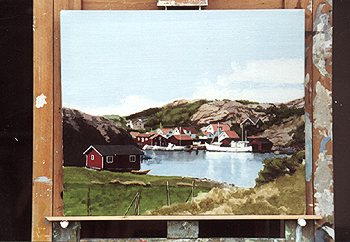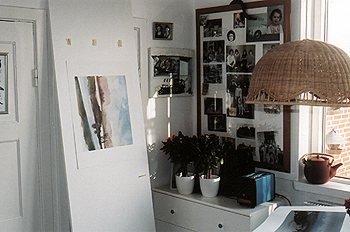| Photographing Artwork It is absolutely necessary that you own photographs of your art. There are many ways to use these photos but I will discuss only how they are to be used to show others what your art looks like. Can I take these photos myself? Of course you can. Begin by thinking that you will eventuelly want two kind of photos but that you will be taking the first and most straight forward typ. These Step One photos are for your own use as documentation and as information. They are not going to be competing for picture of the year. Step Two photos are technically advanced professional photos for use in newspapaers, magazines, for reproductions, posters etc. When an artist has come to this stage someone else will probably be arranging for this kind of photos. Jag will only be discussing Step One photos. There are only two really reliable ways to achieve Step One photos; marry a photographer or learn to take them yourself. In both cases the camera should always be loaded and easily reachable since you will want it to be really easy to take a picture. If possible easier to take a picture than to not take it. And it is always better to take it now than it is to wait untill you are quite sure the painting is "finished". It will cost very little to take another later on and nothing at all if you are using a digital camera. Which Camera A conventional camera with ordinary film is just fine as is a digital camera. A digital camera delivers pictures directly into a computer or by way of a CD. Buy a digital kamera with the most pixels you feel you can afford but it doesn't have to be the most expensive one. An ordinary 35-mm camera for film requires printing on paper. The print must then be scanned if they are to be used in a computer. Your photoshop can scan direktly from the film to a CD. I find that I can often do a better job at home since I can adjust for each picture individually. Scanners are faily inexpensive and mostly pretty good bet there are many steps in this process and you loose picture quality at every step. An analog camera Purchase a 35 mm reflex camera with a good quality lens. 70 to 90 mm is good but a "normal" 50 mm works too. A built in light meter is good. Other whistles and bells are not necessary. Camera stores used to have quality used cameras for sale for a fraction of the cost of a new camera. You can still find them on the internet. Even a 20-30 year old quality camera will normally have an extreemly good lens which will faithfully reproduce your art. Digital cameras Really cheap digital cameras will give you half sharp pictures but today there are many many really good ones. It is of course great to have a new camera full av helpful features which can be fun to use for other things. Myself, I have a Nikon F70 with a 25-120 mm zoom and a positively ancient Nikon F2 with a 43-86 mm zoom. The old camera does just as good a job taking pictures of paintings as the new one but it is slower in many other situations so my new camera goes wherever I go. Tripod A tripod is helpful also. It doesn't have to be modern and fancy either since it just has to stand in the corner already adjusted for taking a quick photo under the same conditions as last time. But you can probably hand hold the camera is you don't have a tripod. Arrange a place to take your pictures or perhaps two places - one for summer weather and one for winter. Where should I take my pictures? In the summer the best place i outdoors in open shade. Fasten a shelf or brackets on the facade of your building (I prefer east or west facade) where you can set up your paintings one by one approximately at eye height. The background can be important to you if your photos are to be placed in an album and shown to gallery owners. In this case a painted plywood background - dark gray or black - could be placed behind the painting. If the background won't be seen, the best choice is neutral gray. A colored background can affect your camera's auto exposure. Also, a neutral gray can be used to color correct easily in the computer (Photoshop).
Use ordinary "film for color prints" if you choose an ordinary camera. In the winter use 400 ASA film but in the summer choose 100 or not more than 200 ASA.
Complement you pictures with some relaxed views at exhibitions and in your studio but be very strikt with your documentary pictures of paintings. If there is snow on the ground outside the light reflected into the house will be much brighter and you may not have to wait for a sunny day to take your pictures. ©Ann Thulin |
|
|
|
Ann Thulin |

